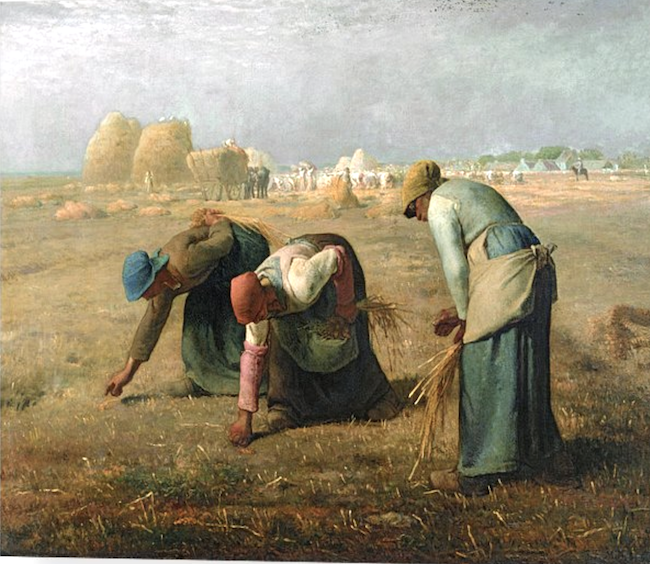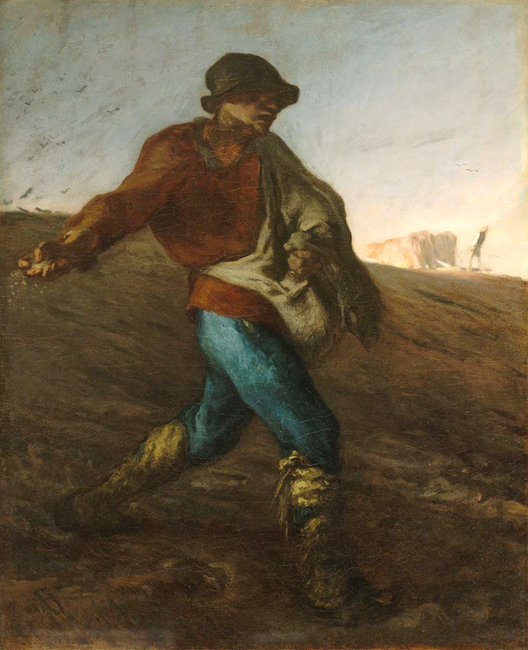Jean-Francois Millet
- HEATHER KING
By the time Jean-François Millet had at last gained some grudging respect from the Paris Salon, his health was failing.
 Jean-François Millet
Jean-François Millet1814-1875
Jean-François Millet (1814-1875), "the painter of peasants," poured his love for the simple laborers of the French countryside into such works as The Sower, The Gleaners, and The Angelus.
Millet was born on October 4, 1814, in the Norman village of Gruchy, to a family of farmers. His parents were both devout Catholics.
As a youth, he worked the fields with his family: mowing, binding sheaves, spreading manure, winnowing, threshing: the "simple" activities he would later enshrine in his work.
He was confirmed at the church of Gréville at the age of twelve. Urged by the vicar to learn Latin, he discovered Virgil and found himself deeply moved by the words: "It is the hour when the great shadows descend toward the plain."

As his friend and biographer Alfred Sensier observed, "the book revealed to him his own surroundings — the life in which he was growing up."
The idea of art began vaguely to form itself in his mind. One day returning from Mass, writes Sensier, Millet "met an old man, his back bowed, and going wearily home. He was surprised at the perspective and movement of the bent figure. This was for the young peasant the discovery of foreshortening. With one glance he understood the mysteries of planes advancing, retreating, rising, and falling. He came quickly home, and taking a lump of charcoal, drew from memory all the lines he had noted."
Millet's father strongly encouraged him to pursue painting, though his departure would mean one less pair of hands for the farm. He apprenticed for a time at Cherbourg under a painter named Mouchel who urged him, "Draw what you like, choose what you please here, follow your own fancy — go to the museum."

About his training, Millet later said, "You have seen my first drawing, made at home without a master, without a model, without a guide. I have never done anything different since."
His first wife died soon after they were married. His second, Catherine, would go on to bear nine children. They moved for a time to Paris and in 1849 settled in the village of Barbizon in north-central France.
Mornings, Millet sowed, reaped, or planted; afternoons, he painted. In spite of his constant labor, for decades he fought off creditors, begged friends for loans, sold pictures in exchange for shoes or a bed.

The critics' response to his rustic scenes of wood-gatherers, charcoal-burners, and quarrymen ranged from disdain to rage. He would not budge on his style.
By the time he had at last gained some grudging respect from the Paris Salon, his health was failing. He knew at least that he would leave the world with his light-dappled Gleaners, his weary peasant couple saying Vespers in the field, his Sower going about his consecrated work of scattering seed.
But perhaps nothing exemplifies Millet's sense of the sacred more than this: he and Catherine had been joined, twenty-two years earlier, in a civil ceremony. On January 3, 1875, they married in accordance with the rites of the Church.
He died, at sixty-two, less than three weeks later.
 This is J. Fraser Field, Founder of CERC. I hope you appreciated this piece. We curate these articles especially for believers like you.
This is J. Fraser Field, Founder of CERC. I hope you appreciated this piece. We curate these articles especially for believers like you.
Please show your appreciation by making a $3 donation. CERC is entirely reader supported.

Acknowledgement
 Heather King. "Jean-Francois Millet." Magnificat (January, 2020).
Heather King. "Jean-Francois Millet." Magnificat (January, 2020).
Reprinted with permission from Magnificat.
Join the worldwide Magnificat family by subscribing now: Your prayer life will never be the same!
The Author

 Heather King is a sober alcoholic, an ex-lawyer, a Catholic convert, and a full-time writer. She is the author of: Parched, Redeemed: Stumbling Toward God, Marginal Sanity, and the Peace That Passes All Understanding, Shirt of Flame: A Year with St. Thérèse of Lisieux, Poor Baby, Stripped, Holy Days and Gospel Reflections, and Stumble: Virtue, Vice, and the Space Between. She lives in Los Angeles. Visit her website here.
Heather King is a sober alcoholic, an ex-lawyer, a Catholic convert, and a full-time writer. She is the author of: Parched, Redeemed: Stumbling Toward God, Marginal Sanity, and the Peace That Passes All Understanding, Shirt of Flame: A Year with St. Thérèse of Lisieux, Poor Baby, Stripped, Holy Days and Gospel Reflections, and Stumble: Virtue, Vice, and the Space Between. She lives in Los Angeles. Visit her website here.


